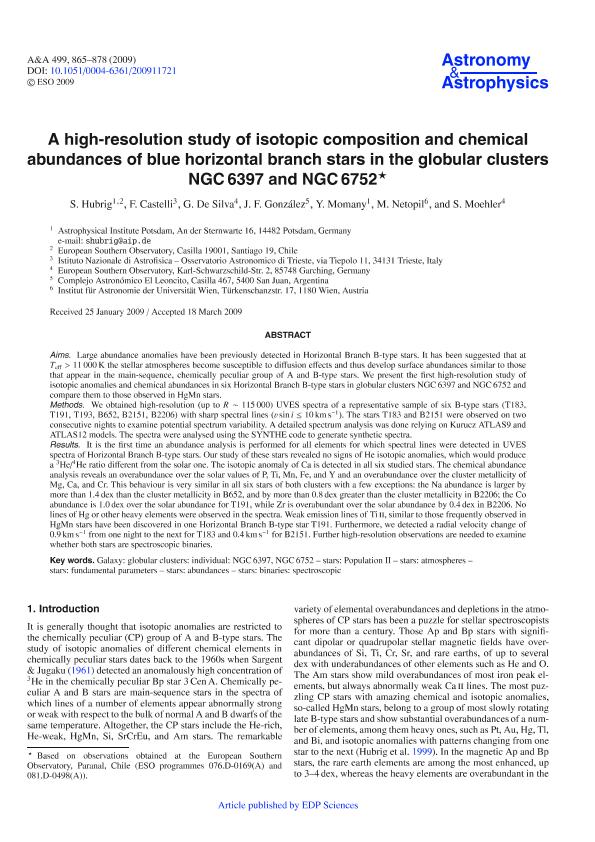Artículo
A high-resolution study of isotopic composition and chemical abundances of blue horizontal branch stars in the globular clusters NGC 6397 and NGC 6752
Hubrig, Svetlena; Castelli, Fiorella; de Silva, G.; Gonzalez, Jorge Federico ; Momany, Y.; Netopil, M.; Moehler, S.
; Momany, Y.; Netopil, M.; Moehler, S.
 ; Momany, Y.; Netopil, M.; Moehler, S.
; Momany, Y.; Netopil, M.; Moehler, S.
Fecha de publicación:
12/2009
Editorial:
EDP Sciences
Revista:
Astronomy and Astrophysics
ISSN:
0004-6361
Idioma:
Inglés
Tipo de recurso:
Artículo publicado
Clasificación temática:
Resumen
Aims. Large abundance anomalies have been previously detected in Horizontal Branch B-type stars. It has been suggested that at Teff > 11 000 K the stellar atmospheres become susceptible to diffusion effects and thus develop surface abundances similar to those that appear in the main-sequence, chemically peculiar group of A and B-type stars. We present the first high-resolution study of isotopic anomalies and chemical abundances in six Horizontal Branch B-type stars in globular clusters NGC 6397 and NGC 6752 and compare them to those observed in HgMn stars. Methods. We obtained high-resolution (up to R ∼ 115000) UVES spectra of a representative sample of six B-type stars (T183, T191, T193, B652, B2151, B2206) with sharp spectral lines (v sin i ≤ 10kms-1). The stars T183 and B2151 were observed on two consecutive nights to examine potential spectrum variability. A detailed spectrum analysis was done relying on Kurucz ATLAS9 and ATLAS 12 models. The spectra were analysed using the SYNTHE code to generate synthetic spectra. Results. It is the first time an abundance analysis is performed for all elements for which spectral lines were detected in UVES spectra of Horizontal Branch B-type stars. Our study of these stars revealed no signs of He isotopic anomalies, which would produce a 3He/4He ratio different from the solar one. The isotopic anomaly of Ca is detected in all six studied stars. The chemical abundance analysis reveals an overabundance over the solar values of P, Ti, Mn, Fe, and Y and an overabundance over the cluster metallicity of Mg, Ca, and Cr. This behaviour is very similar in all six stars of both clusters with a few exceptions: the Na abundance is larger by more than 1.4 dex than the cluster metallicity in B652, and by more than 0.8 dex greater than the cluster metallicity in B2206; the Co abundance is 1.0 dex over the solar abundance for T191, while Zr is overabundant over the solar abundance by 0.4 dex in B2206. No lines of Hg or other heavy elements were observed in the spectra. Weak emission lines of Ti II, similar to those frequently observed in HgMn stars have been discovered in one Horizontal Branch B-type star T191. Furthermore, we detected a radial velocity change of 0.9km s-1 from one night to the next for T183 and 0.4 km s-1 for B215l. Further high-resolution observations are needed to examine whether both stars are spectroscopic binaries.
Archivos asociados
Licencia
Identificadores
Colecciones
Articulos(ICATE)
Articulos de INST.D/CS ASTRONOMICAS D/LA TIERRA Y DEL ESPACIO
Articulos de INST.D/CS ASTRONOMICAS D/LA TIERRA Y DEL ESPACIO
Citación
Hubrig, Svetlena; Castelli, Fiorella; de Silva, G.; Gonzalez, Jorge Federico; Momany, Y.; et al.; A high-resolution study of isotopic composition and chemical abundances of blue horizontal branch stars in the globular clusters NGC 6397 and NGC 6752; EDP Sciences; Astronomy and Astrophysics; 499; 3; 12-2009; 865-878
Compartir
Altmétricas



